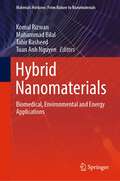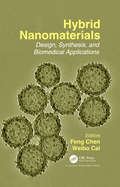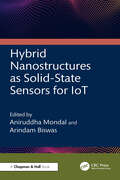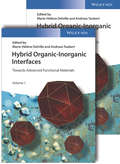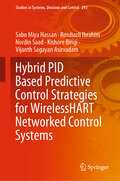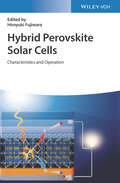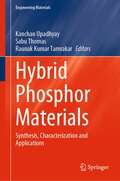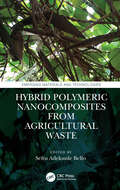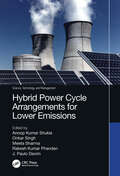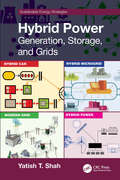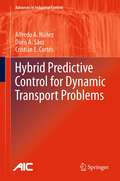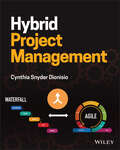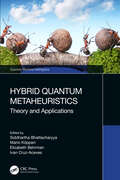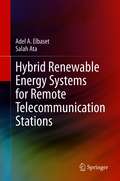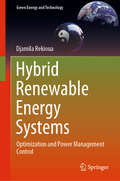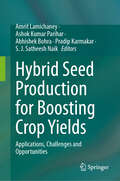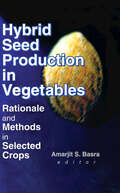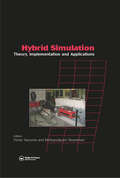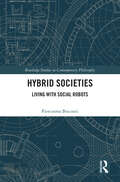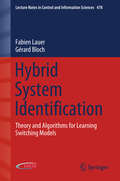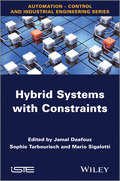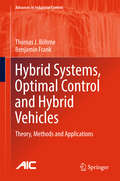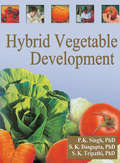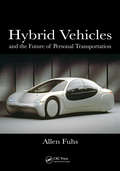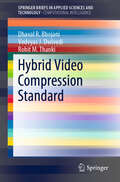- Table View
- List View
Hybrid Nanomaterials: Biomedical, Environmental and Energy Applications (Materials Horizons: From Nature to Nanomaterials)
by Tuan Anh Nguyen Tahir Rasheed Muhammad Bilal Komal RizwanThis book elaborates on the fabrication of organic-inorganic hybrid nanomaterials, their advantages, self-assembly and their applications in diverse fields of energy, biotechnology, biomedical and environment. The contents provide insight into tools, tricks and challenges associated with techniques of fabrication and future challenges and risks. This book also discusses the properties of modern hybrid nanomaterials and their performance, durability, reproducibility and sensitivity. It will be useful for students and researchers in the area of nanotechnology, science, engineering and environmental chemistry. This volume will also be useful for researchers and professionals working on nanohybrid materials.
Hybrid Nanomaterials: Design, Synthesis, and Biomedical Applications
by Feng Chen Weibo CaiOver the last decade, an unprecedented expansion in the field of nanomedicine has resulted in the development of new nanomaterials for diagnosis and therapy of various diseases such as cancer. This book covers the design, synthesis and applications of various functionally-hybridized nanomaterials for biomedical applications. It includes strategies for design and synthesis of hybrid nanomaterials, surface engineering of various nanoparticle-based hybrid nanosystems for cancer imaging and therapy, toxicity aspects of nanomaterials and the challenges in translation research of hybrid nanomaterials.
Hybrid Nanostructures as Solid-State Sensors for IoT
by Arindam Biswas Aniruddha MondalThe book provides an in-depth discussion of various Hybrid Nanostructures as solid-state sensors in the context of the Internet of Things (IoT). It explains the vital role that sensors play in IoT to aid in discovering what possibilities ought to be addressed to make the data more meaningful. The book highlights the applicability of biosensing field effect transistor (FET) technology with a specific emphasis on the progress being made in integrating existing FET technology and nanotechnology, using semiconductor nanowires and organic structures.• Offers in-depth discussion on Hybrid Nanostructures as solid-state sensors• Elaborates upon the fabrication of gas sensors using metal oxide semiconductor nanostructures• Studies biosensors based on metal oxide semiconductor nanostructures• Discusses the suitability of various Hybrid Sensors in solving the problems of the Internet of Things (IoT)• Provides extensive support for the development of Hybrid Nanostructures as solid-state sensorsThe book is meant for researchers and scholars of Computer Science and associated disciplines. It also serves as a valuable reference for graduate students, researchers, seeking to deepen their knowledge and engage with the latest advancements in these Hybrid Nanostructures as solid-state sensors.
Hybrid Organic-Inorganic Interfaces: Towards Advanced Functional Materials
by Andreas Taubert Marie Helene DelvilleHybrid organic-inorganic materials and the rational design of their interfaces open up the access to a wide spectrum of functionalities not achievable with traditional concepts of materials science. This innovative class of materials has a major impact in many application domains such as optics, electronics, mechanics, energy storage, and conversion, protective coatings, catalysis, sensing, and nanomedicine. The properties of these materials do not only depend on the chemical structure, and the mutual interaction between their nano-scale building blocks, but are also strongly influenced by the interfaces they share. This handbook focuses on the most recent investigations concerning the design, control, and dynamics of hybrid organic-inorganic interfaces, covering: (i) characterization methods of interfaces, (ii) innovative computational approaches and simulation of interaction processes, (iii) in-situ studies of dynamic aspects controlling the formation of these interfaces, and (iv) the role of the interface for process optimization, devices, and applications in such areas as optics, electronics, energy, and medicine.
Hybrid PID Based Predictive Control Strategies for WirelessHART Networked Control Systems (Studies in Systems, Decision and Control #293)
by Nordin Saad Rosdiazli Ibrahim Vijanth Sagayan Asirvadam Sabo Miya Hassan Kishore BingiRecent advances in wireless technology have led to the emergence of industry standards such as WirelessHART. These strategies minimise the need for cumbersome cabling, thereby reducing costs. However, applying them involves the challenge of handling stochastic network delays, which can degrade control performance. To address this problem, commonly used simple PID could be employed. However, PID suffers from gain range limitations when used in a delayed environment. Furthermore, model-based controllers are complex and require exact models of the process and systematic system identification for implementation. Therefore, to address these issues, the book proposes control strategies that retain the simplicity of PID in terms of ease of tuning and structure, while improving on the performance of the closed-loop system with regard to stochastic network delays and mismatches. Concretely, it proposes and discusses three strategies, namely: Setpoint Weighting (SW), Filtered Predictive PI (FPPI) and Optimal Fuzzy PID. In order to optimise some of these controllers, two novel hybrid optimisation algorithms combining the dynamism of the Bacterial Foraging Algorithm (BFA) and advantages of both the Spiral Dynamic Algorithm (SDA) and the Accelerated Particle Swarm Optimisation (APSO) have been used. The strategies proposed here can also be applied in stochastic control scenarios (not necessarily wireless) characterised by uncertainties. This book will be useful to engineers and researchers in both industry and academia. In industry, it will be particularly useful to research and development efforts where PID controllers and wireless sensor networks (WSNs) involving both short and long term stochastic network delay are employed. Thus, it can be used for real-time control design in these areas. In the academic setting, the book will be useful for researchers, undergraduate and graduate students of instrumentation and control. It can also be used as reference material for teaching courses on predictive and adaptive controls and their application.
Hybrid Perovskite Solar Cells: Characteristics and Operation
by Hiroyuki FujiwaraBUILDING CODES Illustrated STAY INFORMED OF THE LATEST UPDATES TO THE INTERNATIONAL BUILDING CODE WITH THE LEADING VISUAL REFERENCE In the newly revised Seventh Edition of Building Codes Illustrated: A Guide to Understanding the 2021 International Building Code, architectural drawing expert Francis D.K. Ching and well known architect Steven R. Winkel deliver a beautifully illustrated and intuitively written handbook for the 2021 International Building Code (IBC). The authors provide brand new chapters on plumbing fixture counts, elevators, special construction, and existing buildings while updating the remainder of the material to align with recent changes to the IBC. Easy to navigate and perfect as a quick-reference guide to the IBC, Building Codes IBC Illustrated is a valuable visual resource for emerging professionals. The book also includes: Thorough introductions to navigating the Code, use and occupancy, special uses and occupancies, and building heights and areas Full explorations of the types of construction, fire resistive construction, interior finishes, fire-protection systems, and means of egress Practical discussions of accessibility, interior environment, exterior walls, roof assemblies, and structural provisions In-depth examinations of special inspections and tests, soils and foundations, building materials and systems, and elevators Perfect for students of architecture, interior design, construction, and engineering, the latest edition of Building Codes Illustrated is also ideal for professionals in these fields seeking an up-to-date reference on the 2021 International Building Code.
Hybrid Phosphor Materials: Synthesis, Characterization and Applications (Engineering Materials)
by Sabu Thomas Kanchan Upadhyay Raunak Kumar TamrakarThis book reports the basics of hybrid phosphor materials, their synthesis routes and their special properties and characterization techniques. It gives the reader information about the natural origins and development of hybrid materials, which are developed by combining inorganic and organic species in one material interface-determined materials. The book provides a general classification of hybrid materials, wherein inorganic materials modified by organic moieties are distinguished from organic materials or matrices modified by inorganic constituents. It gives a focus to the functionalization of organic materials by inorganic additives. The application areas covered include optoelectronic field, sensor applications, biological and environmental applications.
Hybrid Polymeric Nanocomposites from Agricultural Waste (Emerging Materials and Technologies)
by Sefiu Adekunle BelloHybrid Polymeric Nanocomposites from Agricultural Waste examines the use of agricultural by-products for green production of new materials. It covers nanoparticle synthesis from agricultural wastes and nanocomposite development with a focus on polyethylene, polylactic acid, polymethylmethacrylate, and epoxy resins, and considers possible biomedical and engineering applications. Showcases agricultural waste as polymer reinforcements to replace expensive synthetic fibres that discourage wide polymeric nanocomposite applications Discusses green synthesis and characterisation of hybrid nanocomposites from polylactic acid, polymethylmethacrylate, recycled/new polyethylene, and epoxy resins Contrasts hybrid nanocomposites properties with standard nanocomposites, using automotive case studies The book is aimed at researchers, advanced students, and industrial professionals in materials, polymer, and mechanical engineering and related areas interested in the development and application of sustainable materials.
Hybrid Power Cycle Arrangements for Lower Emissions (Science, Technology, and Management)
by Anoop Kumar ShuklaHybrid Power Cycle Arrangements for Lower Emissions is an edited book that explores the state-of-the-art for creating effective hybrid power cycles for power generation with lower emission while utilizing different energy sources. The book details energetic and exergetic studies for improving system design and performance of hybrid power cycle arrangements. Chapters in the book provide a systematic approach to the integration and operation of different thermal power cycles with renewable energy sources. The book brings together researchers and practitioners from academia and industry to present their recent and ongoing research and development activities concerning the advancement of hybridization of different conventional and unconventional energy sources to produce efficient and clean energy systems. The book chapters present a range of ongoing research and development activities, challenges, constraints, and opportunities in both theoretical as well as application aspects of several hybrid technologies for power generation. Several issues such as hybridization of different energy sources, availability, environmental impacts, and power cycle integration are addressed in-depth, making this collection a worthy repository for those working in the field of the power cycles.
Hybrid Power: Generation, Storage, and Grids (Sustainable Energy Strategies)
by Yatish T. ShahHybrid energy systems integrate multiple sources of power generation, storage, and transport mechanisms and can facilitate increased usage of cleaner, renewable, and more efficient energy sources. Hybrid Power: Generation, Storage, and Grids discusses hybrid energy systems from fundamentals through applications and discusses generation, storage, and grids. Highlights fundamentals and applications of hybrid energy storage Discusses use in hybrid and electric vehicles and home energy needs Discusses issues related to hybrid renewable energy systems connected to the utility grid Describes the usefulness of hybrid microgrids and various forms of off-grid energy such as mini-grids, nanogrids, and stand-alone systems Covers the use of hybrid renewable energy systems for rural electrification around the world Discusses various forms and applications of hybrid energy systems, hybrid energy storage, hybrid microgrids, and hybrid off-grid energy systems Details simulation and optimization of hybrid renewable energy systems This book is aimed at advanced students and researchers in academia, government, and industry, seeking a comprehensive overview of the basics, technologies, and applications of hybrid energy systems.
Hybrid Predictive Control for Dynamic Transport Problems
by Alfredo Nunez Doris Saez Cristián E. CortésHybrid Predictive Control for Dynamic Transport Problems develops methods for the design of predictive control strategies for nonlinear-dynamic hybrid discrete-/continuous-variable systems. The methodology is designed for real-time applications, particularly the study of dynamic transport systems. Operational and service policies are considered, as well as cost reduction. The control structure is based on a sound definition of the key variables and their evolution. A flexible objective function able to capture the predictive behaviour of the system variables is described. Coupled with efficient algorithms, mainly drawn from area of computational intelligence, this is shown to optimize performance indices for real-time applications. The framework of the proposed predictive control methodology is generic and, being able to solve nonlinear mixed integer optimization problems dynamically, is readily extendable to other industrial processes. The main topics of this book are: · hybrid predictive control (HPC) design based on evolutionary multiobjective optimization (EMO); · HPC based on EMO for dial-a-ride systems; and · HPC based on EMO for operational decisions in public transport systems. Hybrid Predictive Control for Dynamic Transport Problems is a comprehensive analysis of HPC and its application to dynamic transport systems. Introductory material on evolutionary algorithms is presented in summary in an appendix. The text will be of interest to control and transport engineers working on the operational optimization of transport systems and to academic researchers working with hybrid systems. The potential applications of the generic methods presented here to other process fields will make the book of interest to a wider group of researchers, scientists and graduate students working in other control-related disciplines.
Hybrid Project Management
by Cynthia Snyder DionisioHybrid Project Management A how-to guide for leaders of hybrid projects that covers technical and leadership principles across the project delivery spectrum. Hybrid Project Management offers practical guidance for combining waterfall and adaptive (Agile) project management approaches. This helpful guide includes advice on when to use each approach and how various methods can be combined and customized to meet the needs of projects and stakeholders. A sample case study demonstrates how to apply the concepts described throughout the text. An exciting new title from bestselling author Cyndi Snyder Dionisio on a top trending topic in the field, sample topics covered in Hybrid Project Management include: Variables to consider when choosing a development approach Project roles such as sponsors, product owners, project managers, scrum masters, and the project team Launching a hybrid project (vision statements and charters) and structuring the project (development approach, delivery cadence, lifecycle, and roadmap)Project scope requirements, backlogs, and user stories Hybrid scheduling that combines Gantt charts and release plans Leadership in a hybrid project, covering servant leadership, bias, critical thinking, emotional intelligence, motivation, and developing high‐performing teams Managing risk on hybrid projects including estimating reserve and using a risk-adjusted backlog Identifying metrics and reports for predictive and adaptive project work, such as burn charts, variance analysis, forecasts, and cumulative flow diagrams With over fifty percent of projects today being managed using a hybrid approach, Hybrid Project Management serves as an important guide to hybrid project management methods for project management professionals and academia. It is an invaluable resource for understanding the approach and effectively implementing it for better outcomes.
Hybrid Quantum Metaheuristics: Theory and Applications (Quantum Machine Intelligence)
by Siddhartha BhattacharyyaThe reference text introduces the principles of quantum mechanics to evolve hybrid metaheuristics-based optimization techniques useful for real world engineering and scientific problems. The text covers advances and trends in methodological approaches, theoretical studies, mathematical and applied techniques related to hybrid quantum metaheuristics and their applications to engineering problems. The book will be accompanied by additional resources including video demonstration for each chapter. It will be a useful text for graduate students and professional in the field of electrical engineering, electronics and communications engineering, and computer science engineering, this text: Discusses quantum mechanical principles in detail. Emphasizes the recent and upcoming hybrid quantum metaheuristics in a comprehensive manner. Provides comparative statistical test analysis with conventional hybrid metaheuristics. Highlights real-life case studies, applications, and video demonstrations.
Hybrid Renewable Energy Systems for Remote Telecommunication Stations
by Adel A. Elbaset Salah AtaThis book looks at the challenge of providing reliable and cost-effective power solutions to expanding communications networks in remote and rural areas where grid electricity is limited or not available. It examines the use of renewable energy systems to provide off-grid remote electrification from a variety of resources, including regenerative fuel cells, ultracapacitors, wind energy, and photovoltaic power systems, and proposes a powerful hybrid system that can replace the need and high operation costs of batteries and diesel powered electric generators. Analyzes types of communications stations and their rate of consumption of electrical power;Presents brief descriptions of various types of renewable energy;Investigates renewable energy systems as a source for powering communication stations.
Hybrid Renewable Energy Systems: Optimization and Power Management Control (Green Energy and Technology)
by Djamila RekiouaThis book discusses the supervision of hybrid systems and presents models for control, optimization and storage. It provides a guide for practitioners as well as graduate and postgraduate students and researchers in both renewable energy and modern power systems, enabling them to quickly gain an understanding of stand-alone and grid-connected hybrid renewable systems. The book is accompanied by an online MATLAB package, which offers examples of each application to help readers understand and evaluate the performance of the various hybrid renewable systems cited. With a focus on the different configurations of hybrid renewable energy systems, it offers those involved in the field of renewable energy solutions vital insights into the control, optimization and supervision strategies for the different renewable energy systems.
Hybrid Seed Production for Boosting Crop Yields: Applications, Challenges and Opportunities
by Abhishek Bohra Ashok Kumar Parihar Amrit Lamichaney Pradip Karmakar S. J. Satheesh NaikThis book provides an overview of various procedures involved in hybrid seed production of field and vegetable crops, including historical development and principles, maintenance of seed purity of parental lines, evolution of breeding systems, male sterility and self-incompatibility. A section of the proposed book is dedicated to quality control procedures, comprising of purity testing, seed testing and certification process, and seed production management. The major shortcomings of the existing systems, new opportunities and future prospects of hybrid seed production are also discussed. The book focuses on field and vegetable crops like rice, maize, pearl millet, sorghum, pigeon pea, rapeseed, mustard, cotton, castor, soybean, and sunflower among others. This book is for students, researchers, and professionals working in the field of public sectors and commercial seed industries, as well as to other stakeholders who are working to improve their skills on hybrid seed production.
Hybrid Seed Production in Vegetables: Rationale and Methods in Selected Crops
by Amarjit S. BasraProduce hardy, high-yield vegetables with hybrid seeds!From the Preface, by Amarjit S. Basra: “The phenomenon of heterosis, also referred to as 'hybrid vigor,’underlies much of the improvement in crop yields achieved in the twentieth century. The exploitation of heterosis in crop production is of vital importance in facing the challenge of providing food and nutritional security for an ever-increasing human population.“The effective use of heterosis has fostered the development of a worldwide seed industry. Rapid advances in plant breeding and associated seed production technologies have served to enhance the competitiveness of hybrids by increasing crop and seed yield per hectare, reducing the costs involved, and improving seed quality.”Hybrid Seed Production in Vegetables: Rationale and Methods in Selected Crops will help crop scientists and growers increase the quality and yield of vegetables such as: cucumbers cabbage pumpkins squash peppers onions gourds and the fruits watermelon and winter melon. This valuable book provides up-to-date research about heterosis, cultivars, hybrids, and molecular markers to help you get the most quality and quantity out of your seeds. Containing suggestions and methods for overcoming male plant sterility, inbreeding, and challenges to pollination, Hybrid Seed Production in Vegetables will help you successfully breed hybrid plants to produce bountiful and healthy crops.
Hybrid Simulation: Theory, Implementation and Applications
by Victor Saouma Mettupulayam SivaselvanHybrid Simulation: Theory, Implementation and Applications deals with a rapidly evolving technology combining computer simulation (typically finite element) and physical laboratory testing of two complementary substructures. It is a multidisciplinary technology which relies heavily on control theory, computer science, numerical techniques and finds applications in aerospace, civil, and mechanical engineering.
Hybrid Societies: Living with Social Robots (Routledge Studies in Contemporary Philosophy)
by Piercosma BiscontiThis book explores how social robots and synthetic social agents will change our social systems and intersubjective relationships. It is obvious that technology influences societies. But how, and under what conditions do these changes occur? This book provides a theoretical foundation for the social implications of artificial intelligence (AI) and robotics. It starts from philosophy of technology, with a focus on social robotics, to systematically explore the concept of socio- technical change. It addresses two main questions: To what extent will social robots modify our social systems? And how will human relationality be affected by human–robot interactions? The book employs resources from continental philosophy, actor–network theory, psychoanalysis, systemic theory, and constructivist cognitive theory to develop a theory of socio-technical change. It also offers a novel perspective on how we should evaluate the effectiveness of social robots, which has significant implications for how social robotics should be researched and designed. Hybrid Societies will appeal to scholars and advanced students working in philosophy of technology, AI ethics, robot ethics, and continental philosophy.
Hybrid System Identification: Theory and Algorithms for Learning Switching Models (Lecture Notes in Control and Information Sciences #478)
by Fabien Lauer Gérard BlochHybrid System Identification helps readers to build mathematical models of dynamical systems switching between different operating modes, from their experimental observations. It provides an overview of the interaction between system identification, machine learning and pattern recognition fields in explaining and analysing hybrid system identification. It emphasises the optimization and computational complexity issues that lie at the core of the problems considered and sets them aside from standard system identification problems. The book presents practical methods that leverage this complexity, as well as a broad view of state-of-the-art machine learning methods.The authors illustrate the key technical points using examples and figures to help the reader understand the material. The book includes an in-depth discussion and computational analysis of hybrid system identification problems, moving from the basic questions of the definition of hybrid systems and system identification to methods of hybrid system identification and the estimation of switched linear/affine and piecewise affine models. The authors also give an overview of the various applications of hybrid systems, discuss the connections to other fields, and describe more advanced material on recursive, state-space and nonlinear hybrid system identification.Hybrid System Identification includes a detailed exposition of major methods, which allows researchers and practitioners to acquaint themselves rapidly with state-of-the-art tools. The book is also a sound basis for graduate and undergraduate students studying this area of control, as the presentation and form of the book provides the background and coverage necessary for a full understanding of hybrid system identification, whether the reader is initially familiar with system identification related to hybrid systems or not.
Hybrid Systems with Constraints (Wiley-iste Ser.)
by Sophie Tarbouriech Jamal Daafouz Mario SigalottiControl theory is the main subject of this title, in particular analysis and control design for hybrid dynamic systems. The notion of hybrid systems offers a strong theoretical and unified framework to cope with the modeling, analysis and control design of systems where both continuous and discrete dynamics interact. The theory of hybrid systems has been the subject of intensive research over the last decade and a large number of diverse and challenging problems have been investigated. Nevertheless, many important mathematical problems remain open. This book is dedicated mainly to hybrid systems with constraints; taking constraints into account in a dynamic system description has always been a critical issue in control. New tools are provided here for stability analysis and control design for hybrid systems with operating constraints and performance specifications. Contents 1. Positive Systems: Discretization with Positivity and Constraints, Patrizio Colaneri, Marcello Farina, Stephen Kirkland, Riccardo Scattolini and Robert Shorten. 2. Advanced Lyapunov Functions for Lur’e Systems, Carlos A. Gonzaga, Marc Jungers and Jamal Daafouz. 3. Stability of Switched DAEs, Stephan Trenn. 4. Stabilization of Persistently Excited Linear Systems, Yacine Chitour, Guilherme Mazanti and Mario Sigalotti. 5. Hybrid Coordination of Flow Networks, Claudio De Persis, Paolo Frasca. 6. Control of Hybrid Systems: An Overview of Recent Advances, Ricardo G. Sanfelice. 7. Exponential Stability for Hybrid Systems with Saturations, Mirko Fiacchini, Sophie Tarbouriech, Christophe Prieur. 8. Reference Mirroring for Control with Impacts, Fulvio Forni, Andrew R. Teel, Luca Zaccarian. About the Authors Jamal Daafouz is an expert in the area of switched and polytopic systems and has published several major results in leading journals (IEEE TAC, Automatica, Systems and Control Letters, etc.). He serves as an Associate Editor for the key journal IEEE TAC and is a member of the Editorial Board of the IEEE CSS society. Sophie Tarbouriech is an expert in the area of nonlinear systems with constraints and has published several major results in leading journals (IEEE TAC, Automatica, Systems and Control Letters, etc.) and books. She is a member of the Editorial Board of the IEEE CSS society and has also served as an Associate Editor for the key journal IEEE TAC. Mario Sigalotti is an expert in applied mathematics and switched systems and has published several results in leading journals (IEEE TAC, Automatica, Systems and Control Letters, etc.). He heads the INRIA team GECO and is a member of the IFAC Technical Committee on Distributed Parameter Systems.
Hybrid Systems, Optimal Control and Hybrid Vehicles
by Thomas J. Böhme Benjamin FrankThis book assembles new methods showing the automotive engineer for the first time how hybrid vehicle configurations can be modeled as systems with discrete and continuous controls. These hybrid systems describe naturally and compactly the networks of embedded systems which use elements such as integrators, hysteresis, state-machines and logical rules to describe the evolution of continuous and discrete dynamics and arise inevitably when modeling hybrid electric vehicles. They can throw light on systems which may otherwise be too complex or recondite. Hybrid Systems, Optimal Control and Hybrid Vehicles shows the reader how to formulate and solve control problems which satisfy multiple objectives which may be arbitrary and complex with contradictory influences on fuel consumption, emissions and drivability. The text introduces industrial engineers, postgraduates and researchers to the theory of hybrid optimal control problems. A series of novel algorithmic developments provides tools for solving engineering problems of growing complexity in the field of hybrid vehicles. Important topics of real relevance rarely found in text books and research publications--switching costs, sensitivity of discrete decisions and there impact on fuel savings, etc. --are discussed and supported with practical applications. These demonstrate the contribution of optimal hybrid control in predictive energy management, advanced powertrain calibration, and the optimization of vehicle configuration with respect to fuel economy, lowest emissions and smoothest drivability. Numerical issues such as computing resources, simplifications and stability are treated to enable readers to assess such complex systems. To help industrial engineers and managers with project decision-making, solutions for many important problems in hybrid vehicle control are provided in terms of requirements, benefits and risks.
Hybrid Vegetable Development
by Praveen K Singh Shaibal K Dasgupta Subodh K TripathiGet all the resource information you need on hybrid vegetable developmentin one book!Discover the latest concepts in breeding and development of hybrid vegetables with Hybrid Vegetable Development. Respected authorities share their views on the most recent trends and the techniques used for hybrid vegetable development in various
Hybrid Vehicles: and the Future of Personal Transportation
by Allen FuhsUncover the Technology behind Hybrids and Make an Intelligent Decision When Purchasing Your Next Vehicle With one billion cars expected to be on the roads of the world in the near future, the potential for war over oil and the negative environmental effects of emissions will be greater than ever before. Now is the time to seriously consider an alte
Hybrid Video Compression Standard (SpringerBriefs in Applied Sciences and Technology)
by Rohit M. Thanki Vedvyas J. Dwivedi Dhaval R. BhojaniThe book presents compression techniques for digital video stream, describing their design using various image transforms, such as discrete cosine transform (DCT), discrete wavelet transform (DWT), and singular value decomposition (SVD). It first discusses the basic requirements and applications of video compression techniques. The book then addresses video compression using DCT as well as the hybrid compression technique, designed and implemented using DCT, DWT and SVD, demonstrating the simulation results for both. Lastly, it proposes future research directions in the field.
